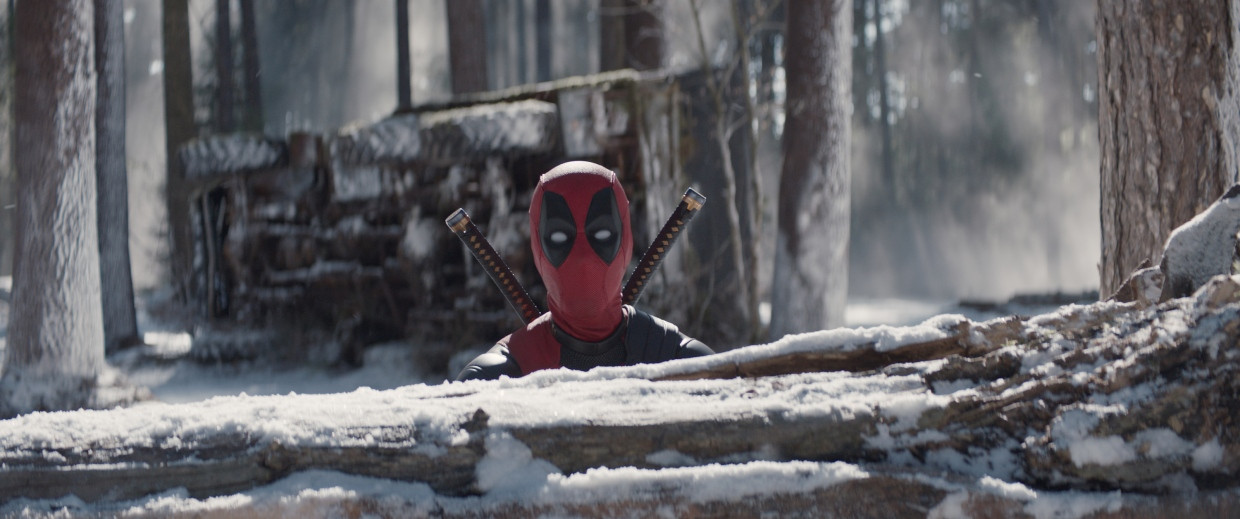Der Abspann bringt Entscheidendes an den Tag (und keine Sorge: Damit wird nichts über das gesagt, was in den zwei Stunden zuvor in „Deadpool & Wolverine“ geschieht; wohl jedoch etwas darüber, wie und warum es geschieht). Der Abspann also enthält anders als sonst bei den zahllosen Marvel-Superheldenfilmen keine als späte Zusatzhäppchen verpackten Vorausschauen auf kommende Ereignisse im MCU („Marvel Cinematic Universe“, wie das durch die sich längst gegenüber den Comics inhaltlich verselbstständigte und finanziell weitaus einträglichere Filmvermarktung geschaffene Geschichtengefüge rund um die altbekannten Heroen bezeichnet wird), sondern lustige Szenenfolgen aus mit Filmausschnitten der bisherigen Kinoauftritte von Deadpool und Wolverine kombinierten Auszügen von Interviews, die deren beide Darsteller zu Beginn ihrer jeweiligen Laufbahnen als Superheldenakteure gegeben haben.
Das war im Falle von Hugh Jackman vor fast einem Vierteljahrhundert, als er 2000 im ersten „X-Men“-Film Wolverine gab, und mit diesem Erfolg ging nicht nur für ihn im Kino alles los, sondern auch für Marvel. Ryan Reynolds mimte dann 2009 erstmals Deadpool (im Jackman-Vehikel „X-Men Origins: Wolverine“) und wurde im nächsten Jahr zum „sexiest man alive“ ausgerufen – was Jackman schon 2008 widerfahren war. Das hatte Witz, weil sich hinter der Maske von Deadpool ein Mann mit verwüstetem Gesicht verbirgt. In den nun gezeigten Abspannszenen sind beide Schauspieler also als deutlich jüngere Männer zu sehen und jeweils unsagbar stolz auf ihre Rollendebüts. Zu Recht, wie sich erweisen sollte: Jackman ist aktuell der dienstälteste aller Superheldenakteure im Kino, Reynolds einer der einträglichsten. Denn seine beiden „Deadpool“-Solo-Filme von 2016 und 2018 waren ökonomische Lichtblicke im sich ansonsten nach dem Höhepunkt des „Avengers“-Zyklus wirtschaftlich verdüsternden Superheldenkino.
The two “Deadpools” were not aesthetically bright spots, although they attempted something new. The title character consistently addressed the audience, and the marketing gimmick provided an opportunity for a number of sideswipes from this not exactly taciturn hero. In “Deadpool 2” he then conquered a kind of time machine that allowed him to correct the past – among other things, the end credits showed him literally erasing his less than friendly first encounter with Wolverine in 2009. It was therefore reasonable to assume that the two would unite to form a similarly contrasting duo as Jerry Lewis and Dean Martin, because as we said: the end credits in superhero films meant a preview.
When the healing factor is no longer of any use
It took six years for it to happen, and Deadpool makes jokes about that in the new film, too, especially since Jackman's character in “Logan – The Wolverine” has since passed away. And so we see Deadpool digging at Wolverine's grave at the beginning – confident that nothing will kill a superhero who, like him, has indestructible healing powers so quickly. But then he comes across his colleague's unmistakable adamantium skeleton, whose individual bones at least become welcome weapons for Deadpool when a group of armed men attack him at the grave. Killing with the remains of a dead person – such cynicism is common in “Deadpool” films, and anyone who doesn't like heavy splatter effects should avoid going to the cinema this time.

Those who have already enjoyed the two rather drastic predecessors will also love the new film, especially since everything happens as usual. In the middle of the opening sequence there is a flashback that explains how Deadpool got to Wolverine's grave in the first place, and the time surveillance authority TVA (“Time Variance Authority”), which was introduced long ago via the MCU's television marketing channel, is now also being brought to the cinema. TVA was originally a comic book invention from the 1980s, and such previously little-used elements of the Marvel world are just what current film adaptations need. In “Deadpool & Wolverine”, Cassandra Nova also makes her screen debut, a character introduced in the comics in 2001 who becomes the main antagonist of the two main characters. Nova rules dictatorially and extremely brutally over a kind of hero dump called The Void, where the TVA dumps its opponents. And that's what happens with Deadpool and Wolverine.
Replacements for dead heroes are plentiful
The latter is dead, but only in one of the countless universes that the MCU uses as a metaverse. Unfortunately, that is precisely the single universe that Deadpool is in, and with Wolverine's death, he too is threatened with extinction – not just Deadpool, but his entire universe! So a new Wolverine is urgently needed, and Deadpool finds one in another universe, but the TVA doesn't like that because it messes everything up. Just like pretty much everything in this film is messed up.
Enough of the confusion during the two hours of “Deadpool & Wolverine” on screen; let's go back to the film's credits mentioned at the beginning with their nostalgic additional scenes. These suggest that the seemingly endless continuation of even the most absurd narrative threads of the MCU will come to an end. Apparently the Disney Group, Marvel rights holder since 2017 and in 2019 also the buyer of the film studio 20th Century Fox, which had previously produced the “Wolverine” and “Deadpool” films (there is also a lot of joking about this here, among other things, in The Void there is a company logo of the acquired studio that has fallen into ruins), is relying less on the sheer volume of further films than on the prominence of the main characters and actors. So for some previously busy actors of less popular superhero characters, the only thing left will probably be what is already eagerly demonstrated in “Deadpool & Wolverine”: cameo appearances that lead to a quick death. Oh yes, after the credits end there is an extra that does not consist of old scenes. But this bonus only sheds new light on a plot thread of the current film. Future? Apparently in Disney's MCU there is only the past.
















